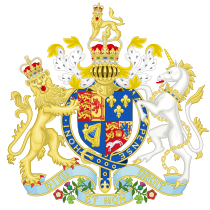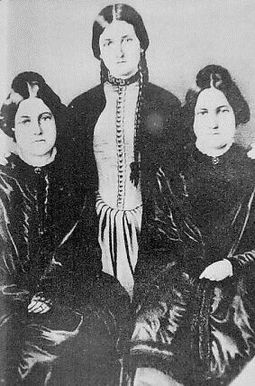Victoria Helen McCrae Duncan (25 November 1897 – 6 December 1956) was a Scottish medium who in March 1944 was the last person to be imprisoned under the Witchcraft Act of 1735 Sometimes dated 1736, an Act of Parliament that repealed the statutes concerning witchcraft throughout Great Britain, including Scotland.,[a]Jane YorkeLast person to be prosecuted under the 1735 Witchcraft Act, in 1944. was the last person to be convicted under the same Act, on 12 September 1944, but perhaps because of her age – she was 72 – she was bound over for three years rather than imprisoned.[1] attributed by some to the fear that she might disclose secrets concerning the preparations for D-day.[2] But the case is undoubtedly the only time a branch of the British military, in this case the Royal Navy, targeted a medium and deliberately attempted to silence her; their motivation may have been to put an end to what they saw as Helen’s exploitation of the widows and orphans of deceased servicemen.[3]
Sometimes dated 1736, an Act of Parliament that repealed the statutes concerning witchcraft throughout Great Britain, including Scotland.,[a]Jane YorkeLast person to be prosecuted under the 1735 Witchcraft Act, in 1944. was the last person to be convicted under the same Act, on 12 September 1944, but perhaps because of her age – she was 72 – she was bound over for three years rather than imprisoned.[1] attributed by some to the fear that she might disclose secrets concerning the preparations for D-day.[2] But the case is undoubtedly the only time a branch of the British military, in this case the Royal Navy, targeted a medium and deliberately attempted to silence her; their motivation may have been to put an end to what they saw as Helen’s exploitation of the widows and orphans of deceased servicemen.[3]
Helen was born in Callandar, Perthshire, the fourth child of Archibald MacFarlane, a slater, and his wife, Isabella Rattray.[2] As a young girl, her tomboyish ways and claimed ability to speak to the dead earned her the nickname Hellish Nell.[4]
After leaving school Helen worked for a time as a hotel waitress, until she became pregnant in 1914. To avoid shaming her Presbyterian family she was sent to Dundee,[2] where the first of her six children,[5] her daughter Isabella, was born in 1915. There she worked in the jute mills and as a nursing auxiliary, and in 1916 she married Henry Anderson Horne Duncan, an invalided soldier she claimed to have met in a dream. The family moved to Edinburgh, where Henry ran a cabinet-maker’s business, and the couple began to promote Helen as a psychic.[2]
Practising medium
In 1926 the Duncans returned to Dundee, where Helen held séances, progressing from clairvoyance to materialisation, allegedly manifesting spirits of the dead by emitting ectoplasm Gelatinous substance that exudes from the body of a spiritualist medium during a seance, which the spirits being communicated with are able to mould into shapes allowing them to communicate with the living. from her body.[2]
Gelatinous substance that exudes from the body of a spiritualist medium during a seance, which the spirits being communicated with are able to mould into shapes allowing them to communicate with the living. from her body.[2]
An early examination of pieces of Helen’s ectoplasm carried out by the London Spiritualist Alliance Educational charity founded in 1884, offering training in mediumship and various divinatory tools. (LSA) concluded that it consisted of a mixture of cheesecloth, paper mixed with the white of egg, and lavatory paper. It was suspected that before her séances she would swallow some of the material, to be regurgitated later. To explore that possibility Helen was persuaded to swallow a tablet of methylene blue,[b]A salt used as a dye and in some medical applications. but when she did no ectoplasm manifested itself.[6]
Educational charity founded in 1884, offering training in mediumship and various divinatory tools. (LSA) concluded that it consisted of a mixture of cheesecloth, paper mixed with the white of egg, and lavatory paper. It was suspected that before her séances she would swallow some of the material, to be regurgitated later. To explore that possibility Helen was persuaded to swallow a tablet of methylene blue,[b]A salt used as a dye and in some medical applications. but when she did no ectoplasm manifested itself.[6]
In 1931 one of the leading psychical researchers of the day, Harry Price, conducted another investigation into Helen’s ability to materialise spirits via ectoplasm. He concluded that Helen was a fraud,[2] and in an appendix to Price’s report the psychologist William McDougall, who attended two of her séances, pronounced Helen’s “whole performance fraudulent”.[7]
In January 1933 Helen was exposed at a séance in Edinburgh as using a stockinet vest to impersonate the spirit of a small girl; she was found guilty at the sheriff court of fraudulently procuring money from the public and fined £10.[2]
Second World War
Helen spent much of her time in Portsmouth during the war, an important Royal Navy base, where she continued to give séances. She predicted the sinking of the British battleship HMS Hood in 1941, with the assistance of her spirit guide Albert.[2] But what seems to have alarmed the authorities was when in that same year the spirit of a sailor reportedly appeared at one of her seancés, announcing that he had just gone down with a ship called the Barham, which was not officially declared lost until several months later;[8] the prime minister, Winston Churchill, had recently ordered that all British losses at sea were to be kept secret.[9][c]So keen was the Admiralty to keep the loss of HMS Barham secret that they sent out Christmas cards with faked postmarks from deceased members of the crew.[10]
According to the researcher Graeme Donald, Helen could quite easily have found out about the sinking of HMS Barham off the coast of Egypt, as although news of the loss was suppressed, letters of condolence were sent to the families of the 861 dead, asking them to say nothing until after the official announcement. So it was at best an open secret, and Helen may simply have attempted to profit from some gossip she had picked up.[11]
Investigation and arrest
By 1943 the authorities were increasingly prosecuting mediums for their exploitation of the bereaved.[2] In 1944 the Royal Navy set up a sting operation involving two Navy personnel, Lieutenant Stanley Worth and Surgeon-Lieutenant Fowler, in concert with two police officers. They agreed to attend one of Helen’s séances and to pounce immediately when her ectoplasm appeared. They carried out their plan on the evening of 19 January 1944,[12] during a séance at the Master Temple Psychic Centre in Portsmouth.[2] As soon as a floating form appeared one of the policemen, Rupert Cross, lunged forward and grabbed it, revealing it to be a “shamefaced” Helen and a quantity of cheesecloth.[12] Helen and three of her audience were arrested:[8] Ernest and Elizabeth Homer, the Master Temple’s owners, and Frances Brown, Duncan’s agent and travelling companion.[2]
The four were initially charged under the 1824 Vagrancy Act,[13] which prohibited anyone from “pretending or professing to tell fortunes, or using any subtle craft, means, or device, by palmistry or otherwise, to deceive and impose on any of his Majesty’s subjects”,[13] a relatively minor offence dealt with by a magistrate, which would probably only result in a fine if proven.[8] But in view of Helen’s past record the magistrate referred them for jury trial at the Old Bailey, to be charged under the 1735 Witchcraft Act Sometimes dated 1736, an Act of Parliament that repealed the statutes concerning witchcraft throughout Great Britain, including Scotland., which allowed for more stringent penalties.[12][d]Despite its name, the Witchcraft Act of 1735 did not make witchcraft itself illegal, only the pretence of fortune telling, sorcery and witchcraft.
Sometimes dated 1736, an Act of Parliament that repealed the statutes concerning witchcraft throughout Great Britain, including Scotland., which allowed for more stringent penalties.[12][d]Despite its name, the Witchcraft Act of 1735 did not make witchcraft itself illegal, only the pretence of fortune telling, sorcery and witchcraft.
Trial and imprisonment
Helen’s trial and that of the others arrested with her began at the Old Bailey on 22 March 1944 and lasted for eight days. Her defence team, funded by the Spiritualists’ National Union, argued that as a genuine medium she could not have acted fraudulently,[2] and suggested that Helen’s credentials could be proven by holding a séance in the court, an offer the trial judge Sir Gerald Dodson declined.[14]
Found guilty despite the testimony of forty-witnesses who claimed to have been reunited with their deceased relatives,[2] Helen was sentenced to nine months imprisonment, but was released after serving six months in Holloway Prison. Francis Brown was sentenced to four months, and the Homers were bound over.[2][e]A device in English jurisprudence exercised in cases of minor misdemeanours in which the accused commits to being of good behaviour for a certain period of time in the future, subject to a penalty if that commitment is not honoured.
Later life and death
Following her release from Holloway on 22 September 1944, Helen succeeded in steering clear of further attention from the authorities until November 1956, when police raided a séance being held in a house in Nottingham, having received information that she was practising again.[15] Helen subsequently exhibited “strange burns”, where it was suggested that ectoplasm had surged back into her body as the police broke up the séance. Helen fell ill, and was treated at hospital and at her Edinburgh home, where she died on 6 December 1956. The official causes of death were given as diabetes and cardiac arrest.[2]
Contrary to what has been claimed by some Spiritualists System of beliefs and practices intended to establish communication with the spirits of the dead., there was nothing strange or unusual about Helen’s death; nor was it caused by the police disturbing her “trance”. Her medical records show that she had a long history of poor health, and as early as 1944 was described as an obese woman who could move only slowly, as she suffered from heart trouble.[16]
System of beliefs and practices intended to establish communication with the spirits of the dead., there was nothing strange or unusual about Helen’s death; nor was it caused by the police disturbing her “trance”. Her medical records show that she had a long history of poor health, and as early as 1944 was described as an obese woman who could move only slowly, as she suffered from heart trouble.[16]
Notes
| a | Jane YorkeLast person to be prosecuted under the 1735 Witchcraft Act, in 1944. was the last person to be convicted under the same Act, on 12 September 1944, but perhaps because of her age – she was 72 – she was bound over for three years rather than imprisoned.[1] |
|---|---|
| b | A salt used as a dye and in some medical applications. |
| c | So keen was the Admiralty to keep the loss of HMS Barham secret that they sent out Christmas cards with faked postmarks from deceased members of the crew.[10] |
| d | Despite its name, the Witchcraft Act of 1735 did not make witchcraft itself illegal, only the pretence of fortune telling, sorcery and witchcraft. |
| e | A device in English jurisprudence exercised in cases of minor misdemeanours in which the accused commits to being of good behaviour for a certain period of time in the future, subject to a penalty if that commitment is not honoured. |

